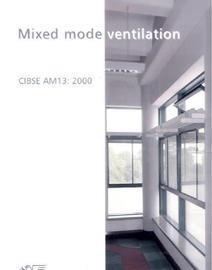A new CIBSE guide on the advantages and pitfalls of mixed mode ventilation offers a fresh insight into the popular servicing strategy of combining natural ventilation with mechanical ventilation and/or cooling.
Mixed mode ventilation is not new, but although the systems involved will already be familiar to building services specialists, integrating these systems with passive building elements and finding the best methods of control can present difficulties.
Mixed mode ventilation delivers the broad level of knowledge required to make strategic decisions about mixed mode systems. It also gives information on how to overcome the specific pitfalls that can befall designers. It uses a wealth of information from surveys of completed buildings to alert users to the potential problems. The text includes a mixture of best practice and innovative thinking.
Designed expressly to help designers produce robust, effective and efficient solutions, it will also help all members of the design and construction team and their clients to understand the issues involved from inception and briefing to handover and operation.
Mixed mode techniques present clear advantages to developers, owners, designers and occupiers of buildings if used correctly.
For developers it is a cost-effective approach which appeals to a wide variety of customers. It can provide the flexibility people expect, but often do not get, from full air conditioning systems, but at a lower cost and with lower energy, management and maintenance requirements.
For owners and investors it is a good short-term and long-term investment offering a smooth transition to more sustainable buildings. It is adaptable to a wide range of occupant requirements and is more readily sold or let than fully naturally ventilated properties.
A mixed mode system also demonstrates care for occupiers, the environment and no-frills waste avoidance.
For designers, mixed mode ventilation can make it easier to suit a building to unforeseen user needs – a big bonus when usage is changing rapidly. It can also rescue buildings that require some localised additional cooling or heat removal or where traffic levels have increased at one facade.
Building or facilities managers may find that a mixed mode strategy offers a greater adaptability with lower costs, maintenance and management burdens.
The success of mixed mode ventilation or any other low-energy concept depends on the collaboration between design team members. This book will tell users how to achieve the best results from this widely known but often poorly operated technology.
Source
Building Sustainable Design






















